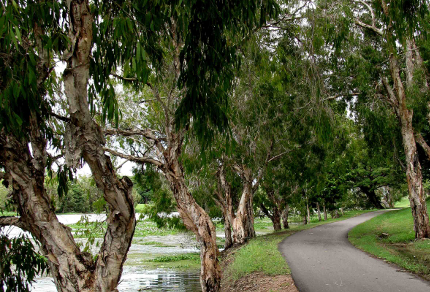
Paperbarks in Ross River Parkway, Townsville (© Magi Nams)
Two huge paperbark trees on my street are in blossom, pumping out waves of ‘boiled-potato’ fragrance and attracting hordes of nectarivorous (nectar-feeding) rainbow lorikeets. The lorikeets (affectionately called ‘lories’ by members of the Townsville Region Bird Observers Club) seem unable to feed in silence, instead squealing and squawking shrilly while they lap up floral nectar with their brush-tipped tongues. As a result, I write this post while being assailed not only by an overpowering reek of boiled potato wafting through my screen door, but also by the jolting, disruptive calls of the lorikeets. Six months ago, it was frogs released from silence by the daily deluges of the Wet that flooded my sodden yard with noise in the form of high-amplitude mating songs. And in the night, even now after six months, flying foxes continue to squabble for food in trees across the street while bush stone-curlews on the Townsville Golf Course wail selections of haunting, demented symphonies into the darkness.
All this racket and scent has led me to conclude that Queensland’s tropical region doesn’t do anything by halves. Parts are drier; parts are wetter, but it’s all a vibrant hodge-podge of life feeding and mating and growing and entrancing humans while occasionally nearly driving them around the bend. Palm trees fling curving fronds against clear skies or blue oceans, leading you to believe you’ve discovered paradise. Then summer’s heat and humidity knock that thought right out of your reeling head that’s doing its best to cope with a body constantly dripping sweat. Winter arrives in all its refreshing glory only to incite the local birds into going bananas over paperbarks and to bring ever-increasing dryness that sucks vitality from the landscape.
Last evening, I signed out library books about Queensland’s rainforests and wildlife. I’m well aware that most of this state is not rainforest, that its area encompasses part of the Simpson Desert as well as vast stretches of savannah woodland and cattle stations, sugarcane plantations, fruit plantations and orchards, market gardens, and so on. However, a lot more of it was rainforest (and woodland) before European settlers arrived on the scene and decided those messy rainforests and those open woodlands of spindly, crooked gum trees were just an impediment to raising sheep and cattle or growing bananas or sugarcane and therefore had to go. This was called progress. More recently, Queensland’s wet tropical ecosystems have been recognized as possessing global significance and ascribed value for what they are. Lush. Diverse. Messy with life. This recognition has provided protection (World Heritage Area status) for remnants of what was once much greater.
The library books presented stunning photographs of Queensland rainforest life – the blue and orange river crayfish found only in streams on Mount Lewis, the soft-furred, cuddly-looking lemuroid possums, the tree kangaroos with short ears and strong forelimbs and ropey tails, the spotted cuscus with its plush orange and white fur, a host of brilliantly-coloured butterflies including the exquisite blue and black Ulysses swallowtail, vividly-hued reptiles, amphibians, birds, and flowers.1 Some of these Vilis and I have been fortunate enough to see during our rainforest explorations in Paluma Range, Girringun, and Wooroonooran National Parks north of Townsville. Others, we will seek in further rainforest explorations.
This coming weekend, however, we will venture inland from the Queensland coast, leaving the realm of wet tropical rainforests and exotic fruit plantations to travel northwest to Undara Volcanic National Park. This drive will lead us through hundreds of kilometres of big sky country – open savannah woodland and grassland, giving us a first taste of Queensland’s dry interior and a different view of the tropics. Having fallen hard for the rainforests, I’m hoping Undara, with its volcanic history and lava tubes, will surprise me.
References:
1. Geoff Higgins and Dalys Newman. Australia’s Rainforests. 1990. Child & Associates Publishing Pty Ltd, Frenchs Forest, New South Wales, 48 p.; Densey Clyne. Australian Rainforests. Reed New Holland, Sydney, 97 p.


